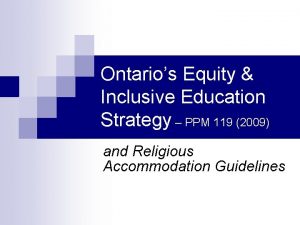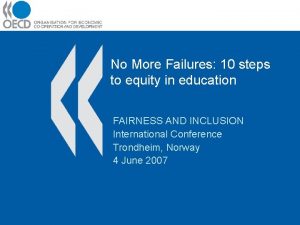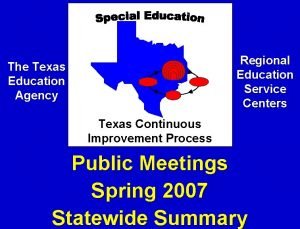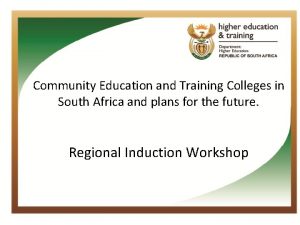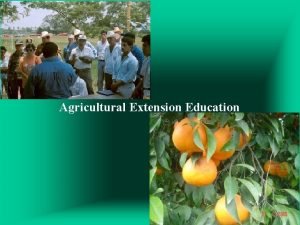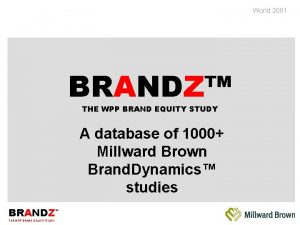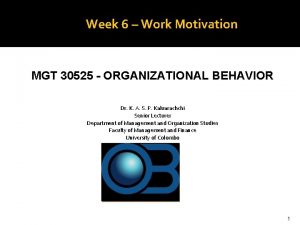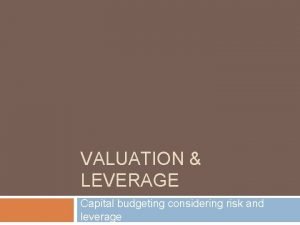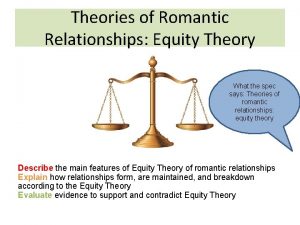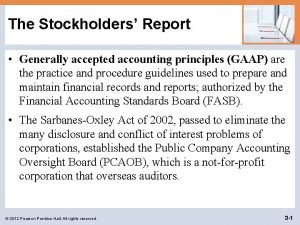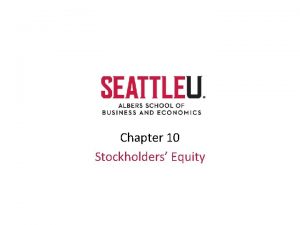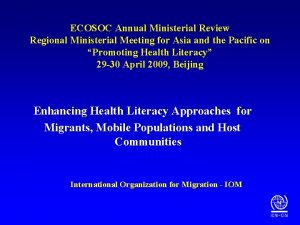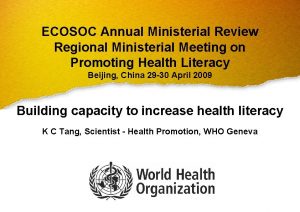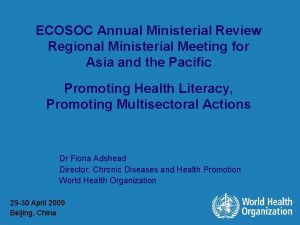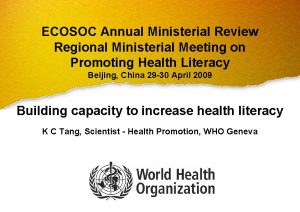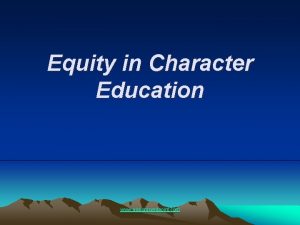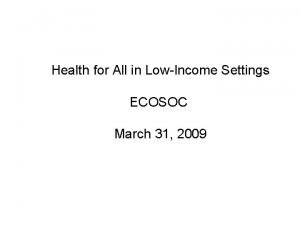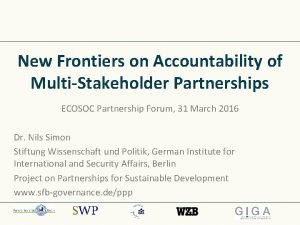Education with Equity in Africa ECOSOC Africa regional















- Slides: 15

Education with Equity in Africa ECOSOC Africa regional meeting Lome, Togo 12 April 2011 Yumiko Yokozeki UNICEF Western and Central African Regional Office

Argument for education – MDGs 2 and 3 and more • Child right argument: basic education is children’s right. • Health argument: basic education contributes to reduction of child and maternal mortality. • Economic argument: basic education helps people come out of poverty. • Governance argument: basic education cultivates good governance. • Power of education: 2+3=8 and more

Vast disparity in access and quality – global, regional and country-wide • Africa region has the lowest enrolment ratio (NER primary education is about 80%) with diversity. • Estimated 31 million or more school-aged children are out of school in 52 countries. • In many countries with lower enrolment ratios, the quality of educational supply is limited. • Within each country, disparity is evident in economic quintiles, gender, ethnic groups/geographical areas and rural-urban data.

Sahel countries show a sharp contrast between the richest quintile and the rest. 100% Burkina Faso 82% Niger 80% 40% 60% 52% 60% 33% 70% 39% 40% 26% 28% 1 2 32% 37% 20% 0% 1 2 3 4 5 0% 3 100% Some post-conflict countries show the same contrast. 4 5 Liberia 80% 66% 60% 37% 40% 23% 42% 26% 20% 0% 1 2 3 4 5

Other countries show a sharp contrast between the poorest quintile and the rest. Cameroon 100% 81% 87% 100% 92% 80% 60% 50% 40% 20% 0% 1 2 3 4 Ghana 98% 5 0% 72% 1 2 3 4 5 79% 78% 4 5 Nigeria 74% 80% 54% 60% 40% 86% 59% 100% Some other countries have the bottom two quintile distinctly disadvantaged. 77% 82% 33% 20% 0% 1 2 3

r ge ge ria Ni Ni i al M a n an Gh ni Be e ee an i in Gu ia ne Le o rit au M Sie rra er Lib l on er o m Ca ga ne Se o as a. F a ire Ivo d' in rk Bu te Co m bi Ga Primary school attendance in rural and urban children 100 90 80 70 60 50 40 urban rural 30 20 10 0

Geographical disparity in Cameroon 100% 90% 80% 70% 60% 50% 40% 30% 20% 10% 0% la D a ou e Yao d un a Ad a ou a m e C tr en Est e rem t x E rd No al or Litt rd No r No est u d. O est Ou Sud Su st ue O d

Geographical disparity in Guinea 100% 90% 80% 70% 60% 50% 40% 30% 20% 10% 0% ke Bo kry C a on ah an Far kan n a K Kin dia e Lab m Ma ou ré ko é r é N’Z

Educational marginalization- combination of economic, rural-urban, gender and ethnic factors The case 14 of Nigeria Ukraine Average number of years of schooling 12 Cuba 10 Bolivia Indonesia 8 6 9. 7 years Richest 20% 10 years Rural Urban 10. 3 years Rich, rural boys Rich, urban boys Rich, rural girls Boys Girls Honduras Nigeria. Cameroon Urban 6. 4 years 6. 7 years Bangladesh Poor, urban boys 4 Education poverty Chad Poorest 20% 3. 5 years Rural 3. 3 years 2 Poor, rural girls 2. 6 years Extreme education poverty 0 C. A. R. Rural Hausa 0. 5 years Poor, rural Hausa girls 0. 3 years

Access to primary education in Cote d’Ivoire 100. 0% rich 90. 3% 76. 6% boys south 64. 4% north 72% National average 86. 6% south 67. 1% girls 51. 1% north Allain Mingat (2009) 71. 8% poor 84. 7% rich 46. 7% poor 93. 7% rich 82. 6% poor 77. 8% rich 30. 9% poor

Equity analysis in education: analysis of constraints and barriers and measures Who are deprived ? Major constraints Measures to include these children

Some good news … • In many countries, the gap between the groups in access in primary education is narrowing. • In Western Cape in South Africa, the learning gaps between the rich and the poor have reduced significantly (next slide). • Ghana and Tunisia recorded the largest gains in the world in science scores in 8 th grade from 2003 through 2007 and among the largest gains in mathematics score (TIMSS 2003/2007).

Western Cape narrowed the literacy inequality gap in 4 years – the bottom three quintiles caught up to the second richest. Source: Mc. Kinsey & Co Report 2011

Conclusion • Regional and national disparity is evident. • In-country disparity is vast and this can be betterunderstood by intersection of multiple factors – economic, gender, geographical region, social norms, etc. • Equity-focused analysis – 1) identifying the determinants of deprivation and major causes of such deprivation, and 2) prioritising strategic shifts in intervention

Thank you very much for your attention
 Ppm 119
Ppm 119 10 steps to equity in education
10 steps to equity in education Texas regional education service centers
Texas regional education service centers Community colleges in south africa
Community colleges in south africa Formal and non formal education venn diagram
Formal and non formal education venn diagram Difference between health promotion and health education
Difference between health promotion and health education Types of extension education
Types of extension education Brandz pyramid
Brandz pyramid What does equity look like
What does equity look like Starbucks brand elements
Starbucks brand elements Equity theory
Equity theory Bny mellon health savings account
Bny mellon health savings account What is interest tax shield
What is interest tax shield Relationship equity theory
Relationship equity theory Examples of economic equity
Examples of economic equity Return on common stockholders' equity ratio formula
Return on common stockholders' equity ratio formula
